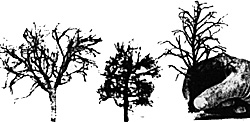 NO, IT'S NOT a typographical error: These trees are all made of string,
twine, or rope. They're easy to make, and you can use them in almost any
scale. A young sprout in 1/35 scale can be an ancient giant in 1/72 scale.
NO, IT'S NOT a typographical error: These trees are all made of string,
twine, or rope. They're easy to make, and you can use them in almost any
scale. A young sprout in 1/35 scale can be an ancient giant in 1/72 scale.
Materials and tools. You can use different kinds of string, twine, thread, or rope. Each produces a different look. For example, heavy nylon carpet thread makes fine, straight branches; twine branches look more helter-skelter.
The equipment is basic. All you need are tweezers; scissors; cotton sewing thread; music wire; super glue or nail polish, typewriter correction fluid; spray paint; and a "third hand" (an alligator clip, a clothespin, whatever) to hold the tree while you work.
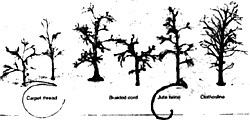 Creating the trunk. I like to make trees with braided, three-strand
cord. Cut 4" of cord and 2' of thread. Knot the thread around one
end of the cord, and wrap a few turns of the thread around the cord to
keep it from fraying at the bottom of the trunk. Next cut a length of music wire slightly longer than the trunk, and file both ends to a point. Run the wire through the bottom of the trunk,
keeping the wire inside the cord. Apply super glue to the trunk from its
bottom to where you want the first branch fork. Super glue stiffens the
trunk. Nail polish is an inexpensive alternative to super glue. However,
it takes longer to dry.
Creating the trunk. I like to make trees with braided, three-strand
cord. Cut 4" of cord and 2' of thread. Knot the thread around one
end of the cord, and wrap a few turns of the thread around the cord to
keep it from fraying at the bottom of the trunk. Next cut a length of music wire slightly longer than the trunk, and file both ends to a point. Run the wire through the bottom of the trunk,
keeping the wire inside the cord. Apply super glue to the trunk from its
bottom to where you want the first branch fork. Super glue stiffens the
trunk. Nail polish is an inexpensive alternative to super glue. However,
it takes longer to dry.
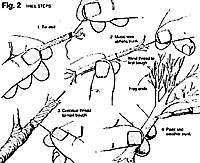 Branching out. Fix the trunk in your "third hand" device
and divide the cord into three main strands. Pull one strand away, go up
the trunk a little, then pull the other two away.
Branching out. Fix the trunk in your "third hand" device
and divide the cord into three main strands. Pull one strand away, go up
the trunk a little, then pull the other two away.
Large Illustration (slow: 50K download)
Super glue the base of these main limbs. Grab one of the three strands with your fingers and use the tweezers to pull away two or three smaller strands. Unwrap these smaller strands into smaller branches.
Repeat this for the other two main strands. Flow on super glue to stiffen all but the very tips of the branches. If you hold the tree up to a light you'll see even finer fibers sticking out from the smallest strandsó like twigs on real trees.
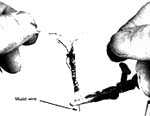 Clothesline. The technique is different for clothesline. Cut about 5 inches of line and pull out the center core from one end. If you want a thicker, stiffer trunk, leave about 1 inch inside the base of the trunk.
Clothesline. The technique is different for clothesline. Cut about 5 inches of line and pull out the center core from one end. If you want a thicker, stiffer trunk, leave about 1 inch inside the base of the trunk.
![]() Separate three strands and pull them out of the upper part of the tree.
Hold the bottom of the trunk and fray the strands, working toward the top.
To add more branches, poke a hole in the trunk, spread it open with the
scissors points, then use tweezers to push another set of strands into
the trunk. Stretch the trunk by its base and top, pull each set of branches
up and away from the trunk, and flow a drop of super glue along the inner
part of each branch so the glue runs toward the trunk. Work from the top
down and keep the glue on the inside of each branch so you can divide the
outer portion into smaller branches. Finally, super glue the wire in the
trunk.
Separate three strands and pull them out of the upper part of the tree.
Hold the bottom of the trunk and fray the strands, working toward the top.
To add more branches, poke a hole in the trunk, spread it open with the
scissors points, then use tweezers to push another set of strands into
the trunk. Stretch the trunk by its base and top, pull each set of branches
up and away from the trunk, and flow a drop of super glue along the inner
part of each branch so the glue runs toward the trunk. Work from the top
down and keep the glue on the inside of each branch so you can divide the
outer portion into smaller branches. Finally, super glue the wire in the
trunk.
Larger trees. Larger trees need extra branches; combine more strands. To add branches, strip a separate strand into three pieces and tie it to existing branches. Larger trees also need extra wrapping, to make the trunk thicker as well as to tie the strands. However, I use the same lengths of sewing thread; otherwise it's too easy to get tangled up. When you tie off a thread, leave the end askew to replicate small sucker branches. Reinforce big branches with wire.
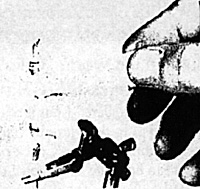 Texture and weathering. Typewriter correction fluid gives the
trunk a bark-like texture, and it smoothes twisted string. Add more fluid at the base and spread out the strands below the thread wrapping to form roots. Super glue stiffens the roots. You can make roots with putty, too.
Texture and weathering. Typewriter correction fluid gives the
trunk a bark-like texture, and it smoothes twisted string. Add more fluid at the base and spread out the strands below the thread wrapping to form roots. Super glue stiffens the roots. You can make roots with putty, too.
Experiment: Let the tree species determine the technique you use to paint and weather it. With spray paint, you'll see the fine fibers thicken as they collect paint. The woven texture of clothesline trees makes good-looking bark. You can make a wash of lamp black in a wide-mouthed jar and dip the tree, or brush on the lamp black. For a gray tree, spray it white and dip it in black. Replicate moss with a yellow-and-green wash at the base.
Think about real trees. You can add foliage to some or all of the branches, depending on the scene. Sparse, light green foliage replicates young spring trees. Use brown or orange foliage for an autumn scene. And if a tree turns out badly, cover it with thick, dark green leaves!
Back to Rebel Yell No. 3 Table of Contents
Back to Rebel Yell List of Issues
Back to Master Magazine List
© Copyright 1997 by HMGS South
This article appears in MagWeb (Magazine Web) on the Internet World Wide Web.
Other military history articles and gaming articles are available at http://www.magweb.com